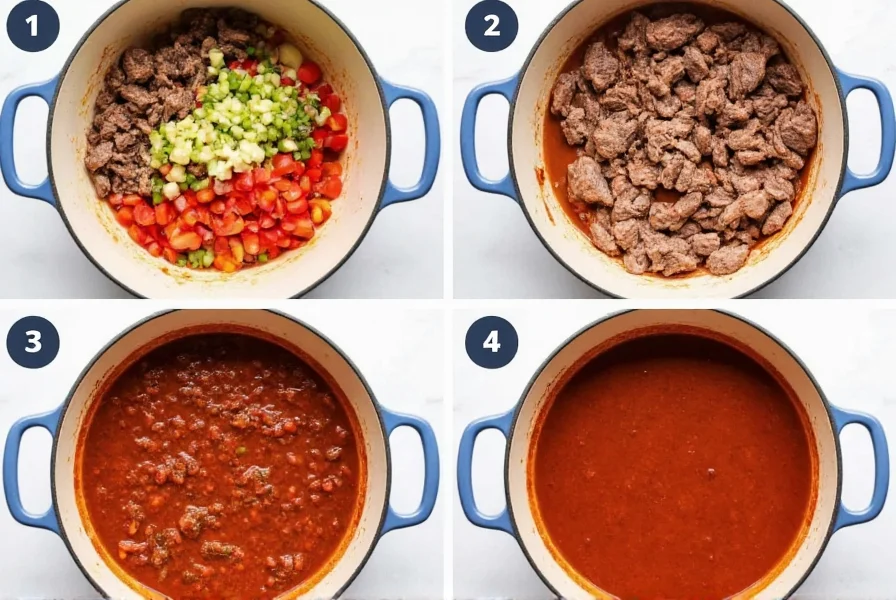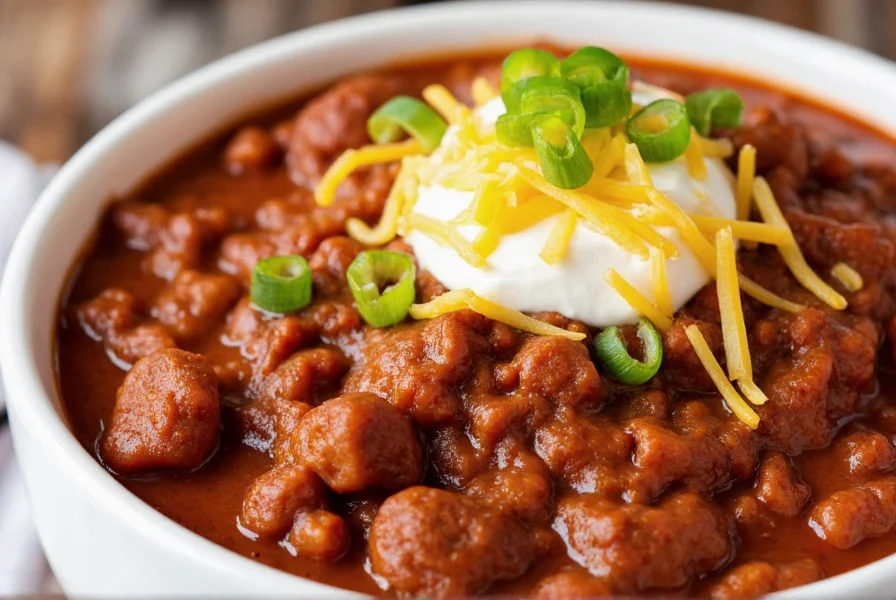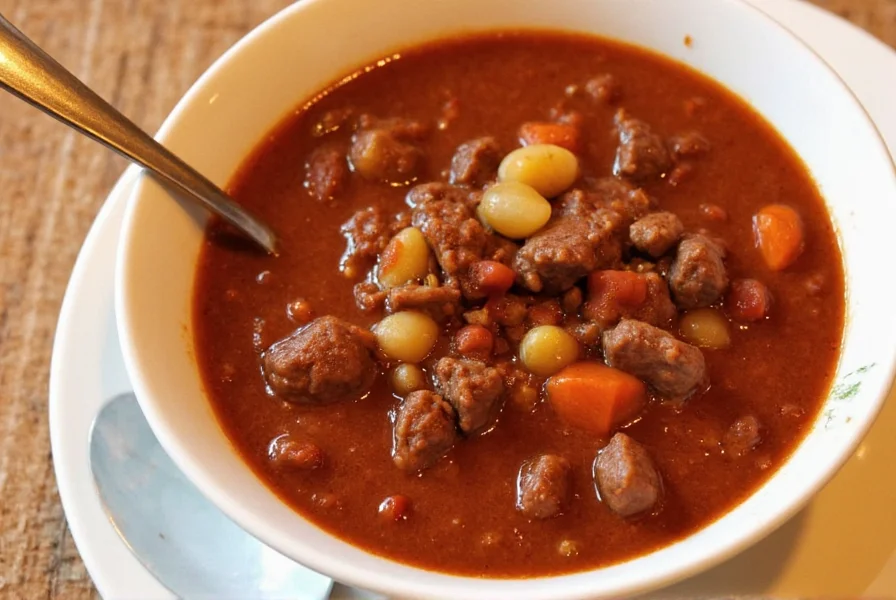Creating exceptional beef chili goes beyond simply combining ingredients—it's about understanding flavor development, texture balance, and regional traditions. Whether you're a beginner or experienced cook, mastering these recipes requires attention to ingredient quality, cooking methods, and subtle flavor adjustments that transform ordinary chili into something extraordinary.
The Essential Components of Perfect Beef Chili
Great chili starts with understanding its foundational elements. The meat-to-liquid ratio, spice balance, and cooking duration all contribute to the final product's character. Traditional beef chili recipes rely on three critical components:
| Component | Key Elements | Impact on Final Dish |
|---|---|---|
| Meat Selection | Chuck roast (cubed), ground beef (80/20), or combination | Chuck provides collagen that breaks down into gelatin for richness; ground beef offers convenience and texture |
| Flavor Base | Onions, garlic, bell peppers, fire-roasted tomatoes | Creates depth and sweetness that balances the spice heat |
| Spice Profile | Chili powder, cumin, smoked paprika, cayenne (optional) | Determines regional character—Texas (meat-focused), Cincinnati (sweet-spicy), New Mexico (chile-forward) |
Classic Beef Chili Recipe for Weeknight Dinners
This straightforward beef chili recipe delivers robust flavor without requiring all-day simmering. Perfect for beginners seeking an easy beef chili recipe for beginners that still honors tradition.

Ingredients
- 1.5 lbs ground beef (80% lean)
- 1 large yellow onion, finely diced
- 1 red bell pepper, finely diced
- 3 cloves garlic, minced
- 28 oz can fire-roasted diced tomatoes
- 15 oz can kidney beans, drained
- 2 tbsp chili powder
- 1.5 tbsp ground cumin
- 1 tsp smoked paprika
- 1 tsp oregano
- 1 cup beef broth
- Salt and black pepper to taste
Instructions
- Brown ground beef in large pot over medium-high heat, breaking into small crumbles
- Add onions and bell peppers, cooking until softened (5-7 minutes)
- Stir in garlic and all spices, cooking for 1 minute until fragrant
- Add tomatoes, beans, and broth; bring to gentle simmer
- Reduce heat to low, cover partially, and cook for 45 minutes
- Season with salt, pepper, and 1 tbsp lime juice before serving
Regional Variations: Exploring Authentic Beef Chili Styles
Understanding regional differences helps you choose the best ground beef chili recipe for your preferences. Each style has distinct characteristics developed through cultural influences and local ingredients.
Texas-Style Beef Chili (Chili Con Carne)
The official state dish of Texas features meat as the star—no beans allowed in authentic versions. This authentic texas beef chili recipe uses cubed chuck roast for superior texture.
| Cooking Method | Time Required | Texture Result |
|---|---|---|
| Stovetop (Dutch oven) | 2.5-3 hours | Rustic, chunky texture with meat that shreds easily |
| Slow cooker | 6-8 hours on low | Extremely tender meat that integrates with broth |
| Instant Pot | 45 minutes plus natural release | Firm meat chunks with concentrated flavor |
Cincinnati-Style Chili
This unique variation features Mediterranean spices like cinnamon and allspice, often served over spaghetti with shredded cheddar. The secret ingredient? A small amount of unsweetened cocoa powder that adds depth without sweetness.
Ingredient Substitutions for Dietary Needs
Adapting traditional beef chili recipes for special diets doesn't mean sacrificing flavor. These substitutions maintain authenticity while accommodating various needs:
- Gluten-free: Use corn masa instead of flour for thickening; ensure broth and spices are certified GF
- Dairy-free: Skip cheese toppings or use nutritional yeast for similar umami flavor
- Keto-friendly: Omit beans and increase meat-to-liquid ratio; add extra healthy fats like avocado oil
- Lower sodium: Use no-salt-added tomatoes and make your own spice blend to control sodium content
Pro Tips for Flavor Development
Professional chefs know that exceptional chili relies on specific techniques that transform basic ingredients into something extraordinary:
- Double-brown your meat: After initial browning, remove meat and continue cooking until fond forms, then deglaze with broth
- Add coffee or chocolate: 1-2 tbsp of strong coffee or unsweetened cocoa enhances meat flavors without being detectable
- Acid balance: Finish with lime juice or apple cider vinegar to brighten rich flavors
- Rest overnight: Chili always tastes better the next day as flavors fully integrate

Common Mistakes to Avoid in Beef Chili Recipes
Even experienced cooks make these errors that compromise chili quality:
- Boiling instead of simmering: Vigorous boiling breaks down meat texture and evaporates delicate flavors
- Adding all spices at once: Toast whole spices first, then add ground spices during cooking for layered flavor
- Skipping the deglaze step: Those browned bits on the pot bottom contain concentrated flavor
- Over-relying on canned chili powder: Freshly toasted and ground spices make a dramatic difference
Serving Suggestions and Toppings
Elevate your best beef chili recipe with these authentic finishing touches:
- Traditional toppings: Shredded cheddar, sour cream, diced onions, fresh cilantro
- Texture enhancers: Oyster crackers, corn chips, or toasted pumpkin seeds
- Serving styles: Over cornbread (classic), with rice (hearty), or as a topping for hot dogs (Cincinnati-style)
Storage and Reheating Guidelines
Proper storage maintains chili quality for future enjoyment:
- Cool completely before refrigerating (within 2 hours of cooking)
- Store in airtight containers for up to 4 days in refrigerator
- Freeze in portion-sized containers for up to 3 months
- Reheat gently on stove with splash of broth to restore moisture
Final Thoughts on Perfecting Your Beef Chili
Mastering beef chili recipes requires understanding both technique and tradition. The best beef chili recipe for cold weather balances rich meatiness with complex spices, while maintaining proper texture. Remember that chili is inherently adaptable—your perfect version might include a splash of bourbon, a dash of fish sauce for umami, or even a touch of espresso powder. The most important element is developing your personal style while respecting the dish's heritage. Whether you prefer the meat-forward Texas style or the spiced Cincinnati variation, attention to ingredient quality and cooking technique will yield consistently delicious results.
Frequently Asked Questions
What's the difference between chili and chili con carne?
Chili con carne ("chili with meat" in Spanish) refers specifically to the meat-based version without beans, which is the traditional Texas style. "Chili" more broadly includes variations that may contain beans, vegetables, or other ingredients. Authentic chili con carne focuses exclusively on meat, chiles, and spices.
How can I make my beef chili less spicy without losing flavor?
Reduce heat by removing seeds and membranes from fresh chiles before adding them. You can also add acidity (lime juice or vinegar) or sweetness (a small amount of honey or tomato paste) to balance heat. Dairy products like sour cream or cheese added when serving will counteract spiciness without altering the cooking process.
Why does my chili taste bland even with plenty of spices?
Bland chili often results from not properly blooming spices. Always cook ground spices in oil or fat for 1-2 minutes before adding liquids to release their essential oils. Additionally, insufficient salt or lack of acid (like lime juice) at the end can make flavors seem flat. Proper seasoning at multiple stages is crucial for depth.
Can I make authentic beef chili in an Instant Pot without losing flavor?
Yes, but with technique adjustments. Use the sauté function to properly brown meat and vegetables first. After pressure cooking, return to sauté mode to reduce excess liquid and concentrate flavors. The key is not to skip the finishing steps that develop complexity, even with faster cooking times.











 浙公网安备
33010002000092号
浙公网安备
33010002000092号 浙B2-20120091-4
浙B2-20120091-4